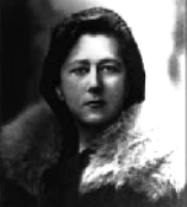
Born: November 24, 1891, Cracow, Austro-Hungarian partition (presently Cracow, Poland)
Died: July 9, 1945, Manchester, England
Early days. Born to a family of artists, Maria Kossak grew up around painters, writers, and intellectuals. Her grandfather, Juliusz Kossak, and her father, Wojciech Kossak, were both professional painters famous for their historical paintings of military leaders and battle scenes. Her younger sister, Magdalena Samozwaniec, was a popular satirical writer. Her first cousin, Zofia Kossak-Szczucka, was a known writer. Maria grew up surrounded by artists, writers, and intellectuals such as Słonimski, Pronaszko, Chwistek, Witkiewicz (Witkacy), and many others. She became fluent in French, English, and German and her world travels later in life greatly affected her imagination. She got home schooling supplemented by many lectures.
Artistic career. In her youth, Kossak painted as often as she wrote poetry. In 1915 she married Wladyslaw Bzowski, an officer in the Austrian army. This marriage was annulled after four years. In 1919 she married Jan Pawlikowski, writer and alpinist. Their passionate relationship based on shared interests and mutual love was the endless source of her poetic inspiration. However, this marriage didn't last either. They separated in 1921 and divorced in 1929. Maria Pawlikowska became active in the community of poets from the Warsaw-based Skamander group: Tuwim, Lechon;, Wierzynski, and renowned writers such as Iwaszkiewicz, Krzywicka, Illakowicz and Boy-Zelenski. She published also in Bluszcz, Wiadomosci Literackie, Tygodnik Ilustrowany, Swiat, Cyrulik Warszawski, Czas, Gazeta Polska. She collaborated with Polish Radio. During the inter-war period Pawlikowska-Jasnorzewska published twelve volumes of poetry and established herself as one of the most innovative poets of the era. She began her career as a playwright in 1924, with her first farce, Archibald the Chauffeur, produced in Warsaw. By 1939 she had written fifteen plays whose treatment of taboo topics such as abortion, extramarital affairs, and incest provoked scandals. She was compared by critics to Moli�re, Marivaux, Wilde, George Bernard Shaw, and Witkacy. Her plays depicted her unconventional approach to motherhood, which she understood as a painful obligation that ends mutual passion. She spoke in support of a woman's right to choose according to her needs and feelings. In 1931 she married Stefan Jasnorzewski, a Polish air force officer; they traveled to France, Italy, Turkey, North Africa and Greece. In 1937 Pawlikowska-Jasnorzewska wrote a controversial play called A Woman of Wonder, (Baba-dziwo) translated into English by Elwira M. Grossman and Paul J. Kelly.
A Woman of Wonder depicts the ruthless dictatorship of [Her Highness] Valida Vrana in a country called Ritonia. Under Valida, people are ranked according to the number of children they have, with boys being the preferred sex. In Ritonia motherhood is not only a compulsory duty but also a tribute to "Her Motherly Highness."
In 1939, at the onset of World War II, she followed her husband to England. In England she collaborated with Polish publications: Wiadomosci Polskie Polityczne i Literackie, Polska Walczaca, Nowa Polska. She was diagnosed with cancer in 1944, became semi-paralyzed, and died in Manchester, England, cared for by her husband.
Awards. 1935- Golden Laurel of The Polish Academy of Literature. 1937- literary prize of the city of Cracow..
Works Niebieskie migdaly, Krakow 1922; Rozowa magia, Krakow 1924; Narcyz 1926; Szofer Archibald. Comedy in 3 acts 1924; Kochanek Sybilli Thompson. Futuristic fantasy in 3 acts 1926; Pocalunki, Warsaw 1926; Dancing. Karnet balowy, Warsaw 1927; Wachlarz, Warsaw 1927; Cisza lesna, Warsaw 1928; Paryz, Warsaw 1928; Profil bialej damy, Warsaw 1930; Egipska pszenica. Play in 3 acts 1932; Mrowki (myrmeis). Play in 3 acts 1936; Referat. Farce in 3 acts, 1968; Zalotnicy niebiescy. Play in 3 acts, 1933; Surowy jedwab, Warsaw 1932; Powrot mamy. Comedy in 3 acts, ; Śpiąca zaloga, Warsaw 1933; Dowod osobisty. Comedy in 3 acts 1936; Nagroda literacka. 1937; Balet powojow, Warsaw 1935; Biedna mlodosc, radio play 1936; Pani zabija pana, radio play 1936; Krystalizacje, Warsaw 1937; Zlowrogi portret, radio play 1937; Baba-dziwo. TragiComedy in 3 acts 1938; Dewaluacja Klary. Comedy in 3 acts 1939; Popielaty welon. Fantazja sceniczna w 9 obrazach 1939; Szkicownik poetycki. 1939; Golab ofiarny, poems 1941; Roza i lasy plonace 1941; Czterolistna koniczyna albo szachownica 1980; Maria Pawlikowska-Jasnorzewska: Biography and A Woman of Wonder in translation at the Toronto University.
This article uses, among others, material from the Wikipedia article "Maria Pawlikowska-Jasnorzewska" licensed under the GNU Free Documentation License. :
Wikipedia ,List of works
Other sources:
Toronto Slavicc Quarterly
University of Buffalo (includes translation of some of her poems and several photographs)
English translations of some of her works:
Constance J. Ostrowski
A bilingual edition of her selected poetry
Anthony Howard with Barbara Bogoczek translated several selections of Polish poetry, including among others Maria Pawlikowska, Butterflies (2000), Wydawnictwo Literackie, Krakow, Poland (still in print.)
Return to home page:
Prominent Poles